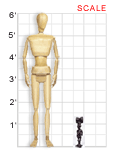VAM galleries including this work:
University of Kentucky Art Museum | World of the Spirit | Art Through Time || VAM Home
African, Nigeria, Yoruba People
FEMALE SHANGO FIGURE, late 19th century
Wood; 16-1/2" X 4-1/2" X 2-1/2"
77.29
University of Kentucky Art Museum
Shango was a powerful Yoruba king and warrior in the 17th century. After his death, Shango was considered to be the god of thunder and lightning because of his fierce nature and aggressive behavior. When the Yoruba people unearthed prehistoric axe heads, they believed them to be thunderbolts that Shango had hurtled from the sky, and thus he is represented by the double-bladed axe. (It is interesting to note that Yoruba territory is subject to one of the highest frequencies of thunderstorms in the world.)
Cult objects of Yoruba gods are used for worship during annual festivals, and this figure may have topped a wooden staff or a shrine. This figure has feminine characteristics and may represent a female devotee or perhaps Oya, Shango’s wife. The burnished color and worn surface (the patina) of the piece are evidence of many years of use. The axe indicates the figure’s possession by Shango, and her calm facial expression reflects the tranquility she has achieved through her worship.
About the Artist
The Yoruba people are an agricultural society living in the southwestern region of Nigeria and the Ivory Coast. Their carvings are known for exaggerated features that enhance the expressiveness of an image. In Yoruba culture, men are the carvers. They hone their skills and learn traditional designs in family or clan workshops. Adherence to established guidelines ensures that the spirit represented will be pleased and more likely to favor the worshiper.
Classroom Ideas
Discussion: Is the body of the Shango figure proportional? If not, which areas has the artist emphasized? Why might the axe be the largest element of the sculpture? Compare this figure to the Shango figure at the Speed Art Museum web site (link below).
Activity: Religion has been an important factor in the production of art throughout time. Choose a specific culture or religion and research how religious beliefs have affected the art associated with it. Create a classroom poster about your findings.
Links
View another Shango figure and other Yoruba objects at the Speed Art Museum web site.
[www.speedmuseum.org/african_art.html]
The University of Iowa art collection also includes several carved wooden figures from the Yoruba and other African peoples.
[artqtserver.art.uiowa.edu:8080/Art%20and%20Life%20CD/]
Read more about Yoruba gods and life at the Rand African Art site.
[www.randafricanart.com/Yoruba_Customs_and_Beliefs_Pertaining_to_Twins.html]

